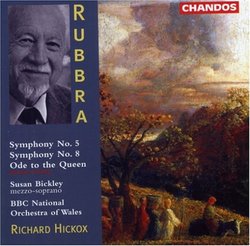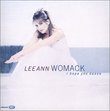| All Artists: Edmund Rubbra, Richard Hickox, Susan Bickley, BBC National Orchestra of Wales Title: Rubbra: Symphonies 5 & 8/Ode to the Queen Members Wishing: 0 Total Copies: 0 Label: Chandos Release Date: 4/13/1999 Genre: Classical Styles: Opera & Classical Vocal, Historical Periods, Modern, 20th, & 21st Century, Symphonies Number of Discs: 1 SwapaCD Credits: 1 UPC: 095115971420 |
Search - Edmund Rubbra, Richard Hickox, Susan Bickley :: Rubbra: Symphonies 5 & 8/Ode to the Queen
 | Edmund Rubbra, Richard Hickox, Susan Bickley Rubbra: Symphonies 5 & 8/Ode to the Queen Genre: Classical
|
Larger Image |
CD DetailsSimilar CDs
|
CD ReviewsFrom the joyous to the mystical Rodney Gavin Bullock | Winchester, Hampshire Angleterre | 05/14/2001 (5 out of 5 stars) "Rubbra's 8th symphony was completed in 1968, ten years after the 7th. It was submitted to the BBC but was turned down. The BBC is the largest commissioning body for new music in the UK and at that time was in the grip of what I can only describe as 'musical pc'. Works that were not serial or otherwise avant garde were looked down upon. The music of Schoenberg, Boulez, Nono and the like were the future and 'conservative' i.e. tonal composers had a very thin time of it indeed. It was eventually given its first performance in 1971 in Liverpool. It was later recorded by Lyrita. Rubbra wrote it in full score instead of orchestrating from a piano draft. The opening is quite magical, conjuring up a mysterious world, somewhere not of this earth. As usual, the music unfolds with the inevitablity of water running downhill. After a variety of moods, the movement finishes with a brief return to the atmosphere of the beginning. The fast movement is a jolly affair. The final, slowish movement commences with a variety of related thematic material. What sounds like a ticking clock appears. This feeling of time passing keeps recurring. After a last climax, the symphony ends with a reprise of the melody on the celesta.Ode to the Queen was commissioned by the BBC in 1953 to celebrate the coronation. It consists of three settings of 16th and 17th century poets. 'Sound forth celestial organ' is unremarkable. 'Fair as unshaded light' is elegiac in mood and very beautiful indeed - a real gem. 'Yet once again, let us our measures move' is joyful and much in the style of some of the composer's Medieval Latin Lyrics.Finally, the 5th symphony. It opens, as so often, with the statement of some basic material - Rubbra often said that he had to get the beginning right, then everything else would follow. Hickox takes it at a fairly slow tempo compared to Barbarolli and Schoenzeler, but Rubbra again said conductors were always taking his music too quickly. The pace rapidly picks up and we are enjoying this wonderful, happy music. The fast movement is colourful and rhythmic. The slow movement is gravely beautiful, and the first part leads to a plaintive melody on the oboe over slightly menacing drum beats. After a brief, more upbeat climax, the grave music returns. The last movement is again rhythmic and high-spirited but the music suddenly slows and brings the work to an end with melodic material drawn from the first movement. This is a very happy symphony and would be a good place to start for someone unfamiliar with Rubbra's music. The performances are all excellent, except for some ragged patches in the 8th symphony. The recording is spacious and the notes quote Rubbra's own words at some length." The Noosphere or Bust! Thomas F. Bertonneau | Oswego, NY United States | 12/12/2000 (5 out of 5 stars) "The Fifth Symphony (1947) is the most recorded symphony out of eleven altogether by Edmund Rubbra (1901-1986), in many ways the successor of Ralph Vaughan Williams in English music. John Barbirolli recorded it for EMI in 1949 (an archival document that goes in and out of circulation); Hans-Hubert Schönzeler recorded it for Chandos in the early 1970s (still available on a Chandos Collect CD at mid-price); and I believe that Stokowski might have recorded it, or at least that a tape of his performance might have been available somewhere for a while. The most recent recording comes courtesy of Richard Hickox, with the BBC National Orchestra of Wales, again on Chandos. The program joins the Fifth with the Eighth (1966-68) and with the orchestral song-cycle "Ode to the Queen" (1953). Commentators have occasionally cited Mahler as an influence on Rubbra at the time of the Fifth, possibly because of the instrumentation in the opening paragraphs of the First Movement (Adagio); to me, it sounds closer to Sibelius, but I would prefer to insist that Rubbra is Rubbra, after all, with his own recognizable rigor and beauty and musical character. The Fifth Symphony differs from earlier installments in the sequence in that it represents a culmination, of sorts, in Rubbra's retreat from the extreme density of counterpoint that marks the First and Second and that lessens somewhat in the Third and the Fourth. Rubbra does not cease to be a "monistic" composer, however, deriving as he does the whole material of his Adagio from the scalar motif given out by the oboe in the first bars over a glowering chord strongly colored by the horns. He develops the motif by the employment of canon, fugue, variation - it's as hermetic as any dodecaphonic composition by Schoenberg, but perfectly in accord with traditional harmony and always sonorous and beautiful. The grim atmosphere of the earlier symphonies gives way to something more hopeful (a luminous Allegro), despite the implied malice of that opening chord. The Scherzo, like the "Périgourdine" of the First Symphony (1935), uses Renaissance dance-rhythms; Rubbra puts his hornpipe-tune through all twelve keys of the harmonic cycle, another demonstration of his heterodoxy-within-orthodoxy. The Third and Fourth Movements are a "Grave" and an "Allegro Vivo," the former serving as an introduction to the latter, as in the Fourth Symphony. The opening motif returns in the end, revealing itself to have been present throughout. The Eighth Symphony reflects Rubbra's interest in the Catholic anthropologist and philosopher Teilhard de Chardin. In three movements, it shows Rubbra perfecting his method of deriving all material in a given work from a few pregnant musical cells, such that the final form lies predicated in the initial gestures. Call it a teleological approach to the symphony, very much in line with Chardin's Bergson-inspired evolutionary mysticism. To the Noosphere, so to speak, or bust! Setting Crashaw, D'Avenant, and Campion, three Elizabethan poets, the song-cycle, reminiscent of RVW's "Five Mystical Songs," matches in music the spirit of the words. But Rubbra dwelt as much in the sixteenth as in the twentieth century, so what else would one expect? Hickox and the Welsh performers deliver their usual smooth-as-cream performance. Chandos' sound is reliably top of the line." Rubbra on Chandos K. Farrington | Missegre, France | 02/11/2000 (5 out of 5 stars) "Yet another excellent offering from Chandos. In the opening of the 8th Symphony the playing of the orchestra has a mysterious sheen which provides the listener with something of the composers true intent. This is something like the atmosphere of parts of Vaughan Williams 9th Symphony and I should think from my knowledge of recordings of this latter work does not always come off in performance. The mood is almost valedictory in places and Rubbra must have been in an introverted mood when he penned this work. Full marks!"
|

 Track Listings (10) - Disc #1
Track Listings (10) - Disc #1![Del Shannon - Greatest Hits [Curb]](https://nationalbookswap.com/cd//m/74/0674/230674.jpg)
